Put higher clocks in your sights with the ROG Crosshair VII Hero
The Republic of Gamers is as OG as PC gaming hardware gets, tracing its origins way back to 2006 with the original Crosshair motherboard. We’ve been improving the formula ever since, and the new ROG Crosshair VII Hero is our most advanced X470 platform for serious tuners. It’s also the most striking, with a black-on-black theme that embraces ROG’s dark side, and an optional stealth mode that defies modern conventions by turning off every single onboard LED.
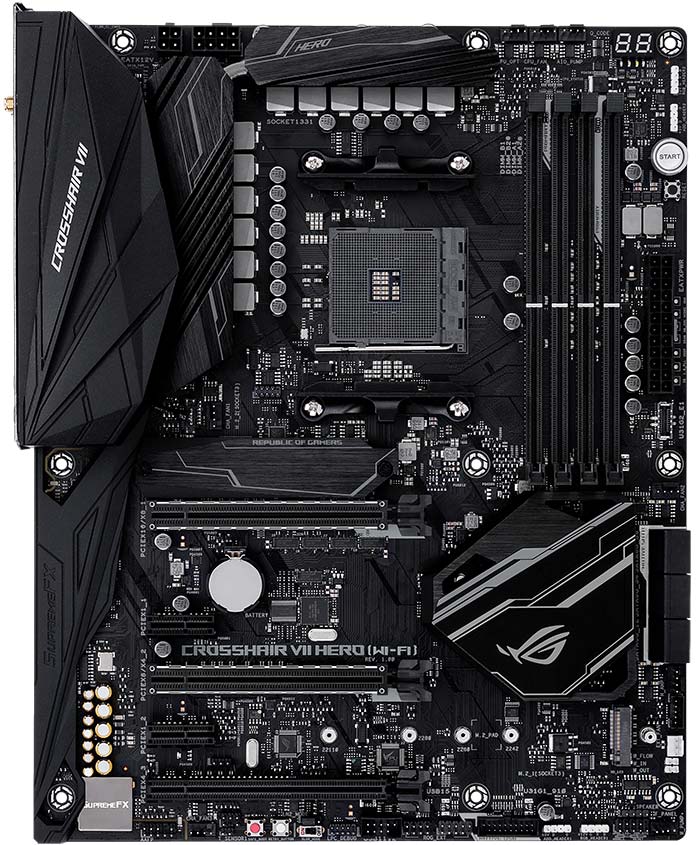
With dual SafeSlots primed for SLI and CrossFireX, the Hero is designed for high-end discrete graphics. There are no display outputs for Raven Ridge’s integrated Radeon, which reduces the power consumed by that portion of the processor, so our engineers redistributed the VRMs accordingly. While the old Crosshair VI Hero allocates power phases to the CPU and SoC in an 8+4 split, its successor uses a 10+2 arrangement that shifts power to the processor cores. This rebalancing works with rearranged phase layouts north and west of the socket to lower VRM temperatures substantially compared to the previous generation. See for yourself in the thermal images below (and click the buttons to switch between boards).
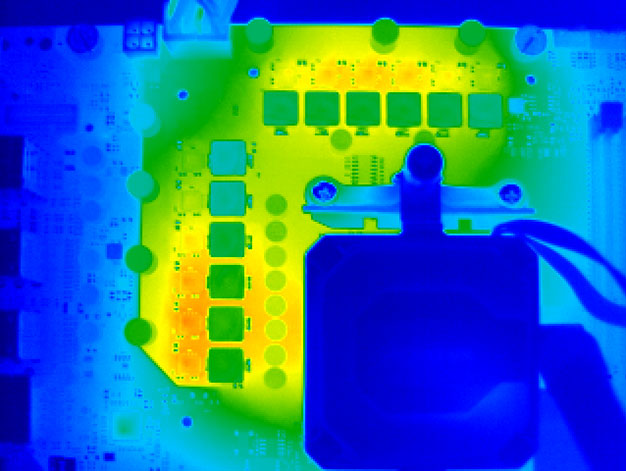
Sharing the load between more VRMs and spacing them out around the socket allows the Crosshair VII Hero to run noticeably cooler, with evenly distributed thermals. Heat is more localized on the last Hero, with higher temperatures for the circuitry supplying the CPU.
Improved power delivery can aid overclocking by making more juice available to the CPU cores. The Crosshair VII Hero also incorporates an external clock generator that lets you raise their base frequency without affecting the rest of the chip. Unlocked multipliers make tweaking the base clock largely unnecessary for most overclockers, but you’ll need to go there to reach the limits of your processor.
We’ve been working closely with world-renowned overclockers to push the Ryzen 7 2700X to the brink on the Crosshair VII Hero. Elmor has already set a new record for the AM4 reference clock, decimating the old mark of 151.56MHz with an incredible 240.61MHz. TheOverclocker has claimed records for peak Ryzen CPU frequency with 6GHz on not only a single core, but also all eight cores and 16 threads. Top scores have also fallen in key benchmarks for eight-core CPUs, with TheOverclocker setting the fastest time in GPU PI for CPU 1B, and Der8auer hitting the top of the Geekbench3 leaderboard.
Precise voltage is vital when you’re on the edge, so the Hero tracks important rails from the best spot on the power plane, and it uses differential sensing to ensure accurate readings from both software and the onboard ProbeIT measurement points. Most motherboards rely on single-ended sensing tapped from a location that isn’t ideal, making it more difficult to gauge exactly how much voltage is being supplied to your components.
With eight onboard headers for fans and pumps, the Hero has the cooling credentials to match its overclocking aspirations. It’s ready for custom liquid loops thanks to a high-amperage pump header that can push up to 3A, plus additional headers for monitoring coolant temperatures and flow rate. If you somehow run out of places to connect fans, the board works with the ASUS Fan Extension card, which supports even more fans and temperature probes.
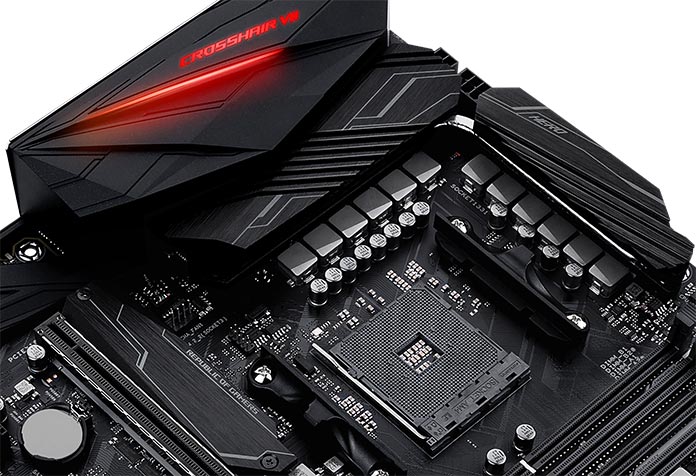
The connector bonanza applies to Aura Sync, with two headers for standard LED strips and two more for addressable RGB gear. Combined with the illuminated I/O shroud and chipset heatsink, there’s enough lighting for an entire system to step out of the shadows.
The shroud surrounds a pre-mounted I/O shield that streamlines installing the motherboard inside a chassis. Along with all the usual suspects, the rear cluster contains a plethora of USB ports that’s perfect for power users with multiple game controllers, VR trackers, and other peripherals. It also houses buttons for clearing the CMOS and activating USB BIOS Flashback, which can flash the firmware with only a power supply and USB drive connected.
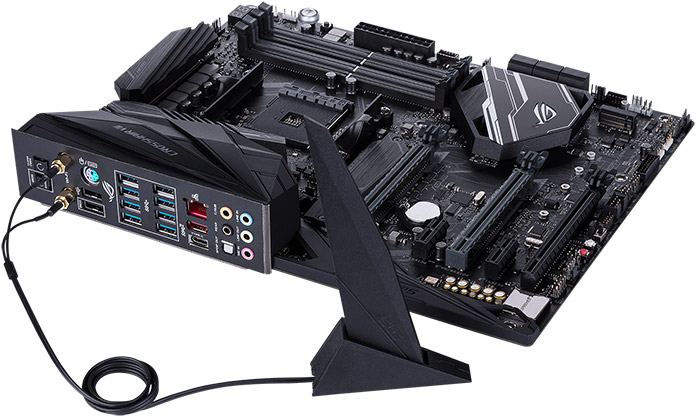
SupremeFX audio completes the package; a premium ESS Sabre DAC and Texas Instruments amplifier produce pristine sound, while a dedicated MOSFET minimizes unwanted popping and helps impedance detection. You can plug headsets up to 600? into the front or rear ports, and the Crosshair VII Hero will sense the impedance and adjust the output accordingly.
| ROG Crosshair VII Hero (Wi-Fi) | |
|---|---|
| Size | ATX |
| Memory | 4 x DDR4 up to 3466+ (OC) |
| Multi-GPU | 2 x SLI, 3 x CrossFireX |
| PCIe | 2 x16 (CPU): x16, x8/x8 1 x16 (Chipset): x4 3 x1 (Chipset) |
| Storage | 1 x M.2 22110 (NVMe x4 or SATA 6Gbps) 1 x M.2 2280 (NVMe x4) 6 x SATA 6Gbps |
| Networking | Intel I219-V Gigabit Ethernet Dual-band 802.11ac WiFi MU-MIMO* |
| Audio | SupremeFX S1220 codec ESS Sabre ES9023P DAC |
| Display | NA |
| USB | 3.1 Gen 2: 1 x front, 1 x Type-C, 1 x Type-A 3.1 Gen 1: 2 x front, 8 x Type-A 2.0: 3 x front, 2 x Type-A |
| Aura | IO shield, chipset heatsink 2 x strip headers 2 x addressable headers |
| Cooling | 2 x pump headers (AIO, pump+) 5 x fan headers 1 x high-amperage fan header 3 x thermal sensor headers (2 x liquid) 1 x flow sensor header |
| Price | $279.99 USD $352.79 CAD $299.99 USD (Wi-Fi) $377.99 CAD (Wi-Fi) |
| Availability (USA) | Newegg Amazon Newegg (Wi-Fi) Amazon (Wi-Fi) |
| Availability (Canada) | Canada Computers Memory Express Canada Computers (Wi-Fi) Memory Express (Wi-Fi) |
With a hint of futuristic death metal and a taste for overclocking, the ROG Crosshair VII Hero comes with and without 802.11ac Wi-Fi. The standard version sells for $279.99 USD and $352.79 CAD, while the Wi-Fi edition retails for $299.99 USD and $377.99 CAD. Look for both boards at the etailers listed above.
The ROG Strix X470-F Gaming lets your build blend in or stand out
Strix brings ROG features to more affordable price points without sacrificing substance or style. The Strix X470-F Gaming embraces the blacked-out theme but adds its own flair with reflective cyber-text that echoes the patterns inscribed on other new ROG gear. If you want to stand out, the dual RGB strip headers and addressable connector make it possible to light up an entire machine without even touching the LEDs behind the I/O shroud.

The Strix X470-F Gaming supports the same multi-GPU configurations as the Crosshair VII Hero. Both of the PCIe x16 slots hang directly off the CPU, enabling a dual-x8 configuration, but the M.2 slots are split between the processor and chipset. The top SSD bay hides under a heatsink and gets four lanes of bandwidth from the adjacent CPU, while the second slot takes two lanes from the chipset at the bottom of the board. The M.2 cooler lowers drive temperatures by up to 20°C, which can help prevent thermal-induced performance throttling during sustained transfers.

The seven headers for fans and pumps are enough for complete system cooling. Two of them are configured for liquid coolers right out of the box, including one with enough oomph to run high-amperage pumps for bigger loops. Although you don’t get the Crosshair’s capacity for monitoring coolant flow and temperatures, there is a connector for standard thermal probes. If your graphics card lacks support for GPU temperature sensing via Fan Xpert, simply attach a wired probe using the auxiliary sensor input on the board.
All the connectivity at the back is set into a pre-mounted I/O shield that gives the Strix X470-F Gaming a clean look from every angle. There aren’t as many USB ports as on the Crosshair VII Hero, but display outputs are available for Raven Ridge Radeons. All the other essentials are covered, including a reversible Type-C connector at the back and a USB 3.1 Gen 2 header for the front.

Dual op-amps with automatic impedance sensing ensure optimal output for a wide range of headphones, but we know power users in particular pipe content through multiple devices. The Sonic Studio III software package that comes with ROG motherboards has an intuitive management interface that lets you route sound from applications to specific outputs, like sending Fortnite to your headset, Spotify to your studio monitors, and YouTube to the speakers in the auxiliary display you use as a TV.
Sonic Studio III also makes game audio more immersive by using a head-related transfer function (HRTF) to simulate surround sound over stereo headphones, and Sonic Studio Link brings that virtualization to Oculus Rift and HTC Vive VR headsets. In-game sounds are mapped to a visible HUD by Sonic Radar III, which is helpful for training your ears to triangulate audible battleground cues.
| Strix X470-F Gaming | |
|---|---|
| Size | ATX |
| Memory | 4 x DDR4 up to 3466+ (OC) |
| Multi-GPU | 2 x SLI, 3 x CrossFireX |
| PCIe | 2 x16 (CPU): x16, x8/x8 1 x16 (Chipset): x4 3 x1 (Chipset) |
| Storage | 1 x M.2 22110 (NVMe x4 or SATA 6Gbps) 1 x M.2 2280 (NVMe x2 or SATA 6Gbps) 6 x SATA 6Gbps |
| Networking | Intel I219-V Gigabit Ethernet Dual-band 802.11ac WiFi MU-MIMO* |
| Audio | SupremeFX S1220A codec |
| Display | DisplayPort 1.2 HDMI 1.4b |
| USB | 3.1 Gen 2: 1 x front, 2 x Type-A 3.1 Gen 1: 2 x front, 1 x Type-C, 5 x Type-A 2.0: 2 x front, 2 x Type-A |
| Aura | IO shield, chipset heatsink 2 x strip headers 1 x addressable header |
| Cooling | 2 x pump headers (AIO, pump+) 4 x fan headers 1 x thermal sensor header |
| Price | $214.99 USD $270.89 CAD |
| Availability (USA) | Newegg Amazon |
| Availability (Canada) | Canada Computers Memory Express |
Plentiful features help the Strix X470-F Gaming strike a balance between performance and personalization without blowing your budget. Get yours for $214.99 USD or $270.89 CAD at the retailers in the table above.
Downsize without compromise on the ROG Strix X470-I Gaming
Despite diminutive Mini-ITX dimensions, the smallest member of our X470 lineup delivers the full ROG experience for gaming rigs and HTPCs with discrete or integrated graphics. That’s an impressive achievement when so much of what defines the Republic of Gamers involves adding functionality that inevitably takes up space. But we’re also known for thinking outside the box, and the Strix X470-I Gaming adds real estate with a unique M.2 Audio Combo Card that combines storage and sound above the board.

Elevating the audio circuitry above the PCB minimizes lateral signal interference that can distort sound. The surface gained allows us to shield the SupremeFX codec and deploy dual op-amps with impedance sensing for headphones. Color-coded lighting is also embedded into the rear ports to create a functional RGB glow that makes it easier to connect audio jacks in dimly lit gaming dens and home theaters.
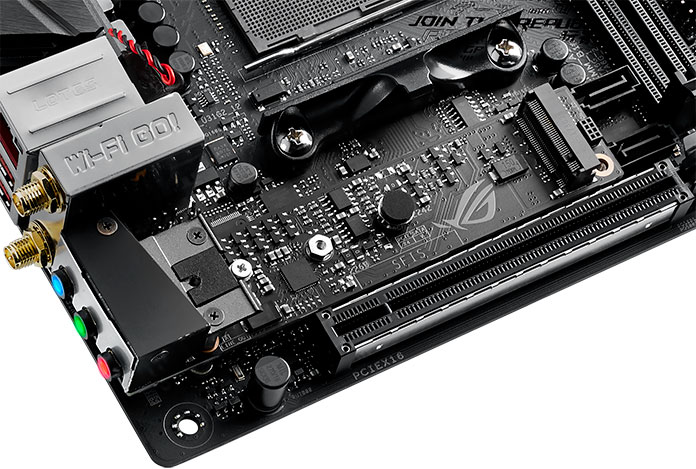
M.2 drives slot into the audio card and are covered by an SSD heatsink that’s especially important given the limited airflow of typical small-form-factor systems. The secondary M.2 slot beneath the main PCB is also handy for bite-sized builds, since it allows an additional drive to be connected without any cable clutter. Like on the Crosshair VII Hero, both M.2s can tap into four lanes of PCIe 3.0 from the CPU, but the secondary one shares bandwidth with the primary x16 slot.
Mini-ITX rigs leave less room for radiators and fans, so the Strix X470-I Gaming gets by with a trio of cooling headers, including one tuned for liquid pumps and AIOs. The board has the same Fan Xpert 4 intelligence as the rest of the ROG family and the same one-click system optimizer. It’s even loaded with Aura Sync lighting, including separate headers for standard and addressable RGB strips. The onboard illumination is more extensive than some of the full-sized boards, with separate zones for the M.2 heatsink and entire right edge of the PCB.

Serious gamers can drop a discrete graphics card into the full-sized PCI Express x16 slot, but that’s unnecessary if you’re running integrated graphics. The board’s HDMI 2.0b is natively supported by the Radeon GPU embedded in Raven Ridge processors. The integrated GPU can drive 4K resolution up to 60Hz with HDR, which is perfect for viewing Ultra HD content on a big-screen TV. While Raven Ridge graphics aren’t powerful enough to run the latest games at that resolution, recent titles reach playable frame rates at 1080p, giving the Strix X470-I respectable performance for a PC gaming console.
The last thing you want behind your home theater is another cable, so the board integrates 802.11ac Wi-Fi for clutter-free connectivity. The dual-band solution uses a 2×2 antenna to accelerate wireless speeds and can push performance further on networks that tap into its MU-MIMO support.
| Strix X470-I Gaming | |
|---|---|
| Size | ATX |
| Memory | 2 x DDR4 up to 3466+ (OC) |
| Multi-GPU | NA |
| PCIe | 1 x16 (CPU): x16 |
| Storage | 1 x M.2 2280 (NVMe x4 or SATA 6Gbps) 1 x M.2 2280 (NVMe x4) 4 x SATA 6Gbps |
| Networking | Intel I219-V Gigabit Ethernet Dual-band 802.11ac WiFi MU-MIMO |
| Audio | SupremeFX S1220A codec |
| Display | HDMI 2.0b |
| USB | 3.1 Gen 2: 2 x Type-A 3.1 Gen 1: 2 x front, 4 x Type-A 2.0: 2 x front |
| Aura | Right edge, M.2 heatsink 1 x strip header 1 x addressable strip header |
| Cooling | 1 x AIO pump header 2 x fan headers 1 x thermal sensor header |
| Price | $209.99 USD $264.59 CAD |
| Availability (USA) | Newegg Amazon |
| Availability (Canada) | Canada Computers Memory Express |
Being a natural fit for Ryzen CPUs with integrated graphics makes the Strix X470-I Gaming the most versatile motherboard in our entire X470 series. It’s available for $209.99 USD and $264.59 CAD from the retailers above.

